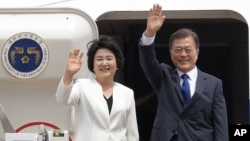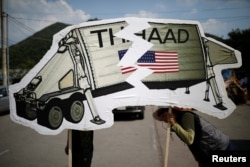U.S. President Donald Trump on Thursday evening hosts South Korean President Moon Jae-in for cocktails and dinner, a prelude to talks the next day on the “very urgent threat posed by North Korea,” according to a senior White House official.
It’ll be the first time the two leaders meet.
Moon, a liberal, took office early last month, succeeding the impeached Park Geun-hye, known for her tough stance toward North Korea.
“It’s going to be a meeting with a lot of uncertainty about whether the two presidents can agree on a common policy toward North Korea in terms of the specific tactics,” said Gary Samore, research executive director at Harvard’s Belfer Center.
For the Trump-Moon meeting, “building a rapport” will be as important as anything else, considering how closely they will be working together, the senior U.S. official told reporters at a background briefing.
“My biggest concern is that President Moon will want to dive into tough policy challenges, rather than focusing on building a rapport with President Trump,” said Mansfield Foundation President Frank Januzzi.
Moon and North Korea
“I believe Moon is coming to Washington with a very specific proposal — if (North Korean leader) Kim Jong Un agrees to pause nuclear and missile testing, that should open the door to a diplomatic engagement, which would try to create a negotiation for eventual nuclear disarmament,” Samore, a non-proliferation and arms control official in the Clinton and Obama administrations, told VOA. “But I don’t know that Trump is going to be in a position to accept that proposal.”
Taro O, adjunct fellow at Pacific Forum CSIS, concurred.
“I don’t think Moon’s messages and various protests in South Korea help to set a positive tone for the summit,” O said.
But O expressed hope the long-standing alliance “would have a soothing effect.”
U.S. officials are downplaying any potential disagreement.
“We’re comfortable with where the two governments are right now,” the senior U.S. official said.
Increasing pressure
The Trump administration desires to substantially increase pressure on Pyongyang “to change its calculus in order to have substantive talks with us when they reduce the threat,” the official said.
Moon and Trump, he added, both want North Korea’s nuclear weapons and ballistic missile development programs completely dismantled.
“Moon might want to adopt an approach that asks Trump for dealmaking advice, even as he expresses the clear will of the South Korean people that dialogue be a key part of any diplomatic strategy to reduce the threats posed by North Korea,” Januzzi, a former East Asia policy director for the Senate Foreign Relations Committee, told VOA.
The U.S. president had hoped that Chinese President Xi Jinping would quickly bring into line North Korean leader Kim Jong Un. But Trump acknowledged recently that Beijing’s influence has failed to dissuade Pyongyang from its provocative course.
“We very much want to see China do more,” the U.S. official said.
“We are adding pressure and have really only begun to do so,” the official added, rejecting criticism that pressure has not worked.
THAAD
Moon also has put the brakes on his predecessor’s move to quickly deploy the U.S. Theater High Altitude Area Defense (THAAD) anti-ballistic missile system in South Korea.
China strongly objected to the presence of THAAD on its neighbor’s territory.
“It is not unreasonable for the U.S. to be perplexed when South Korea appears to disregard a real missile threat from North Korea, succumb to China’s bullying, and portrays THAAD as a U.S. infringement of South Korean sovereignty,” O, a retired U.S. Air Force officer who worked at the Pentagon and intelligence agencies on Korean security issues, told VOA.
Administration officials discount the differences.
THAAD will be “a routine point of housekeeping" in the Trump-Moon talks but it is not being treated as a major issue, the senior White House official said.
Seoul diverging on security matters “could marginalize South Korea as a key player in dealing with North Korea’s nuclear weapons program, especially when Pyongyang is getting closer to developing a nuclear-tipped ICBM that can strike the U.S.,” O said.
Trade issues
There also are trade disagreements between Seoul and Washington, but “it’ll be a friendly, frank discussion,” the senior U.S. official predicted.
Trump has repeatedly termed the U.S.-Korea Free Trade Agreement (KORUS) “horrible.” In April he threatened to terminate the decade-old pact because “we’re getting destroyed in Korea.”
The senior White House official diplomatically acknowledged “there are aspects of the trade relationship that are not in balance.”
Particular irritants: The lack of sales of American-made cars in Seoul and Chinese steel coming into the United States via South Korea.
Moon should have in mind Trump’s job creation agenda and inform him “about the great contributions that Korean companies are making to the U.S. economy, employing hundreds of thousands of Americans, both directly and indirectly,” Januzzi suggested.









